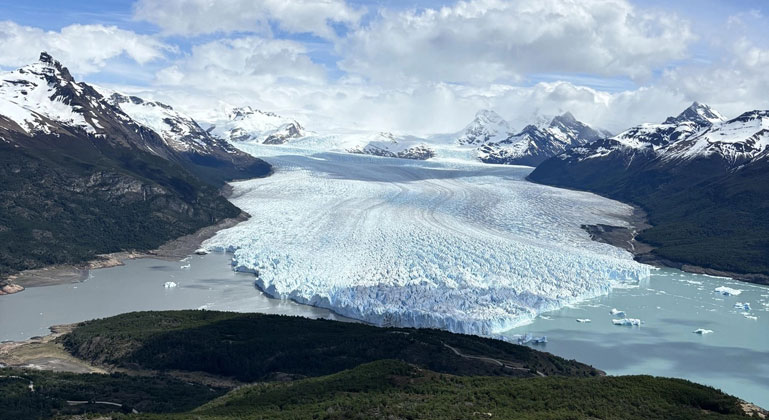Perito Moreno Glacier is detaching from its anchor
One of the most spectacular natural phenomena in the world will most likely no longer be seen in our lifetime: Between 1940 and 2011 the glacier advanced periodically, and when it did, it blocked the Brazo Rico, a side arm of Lago Argentino.
This causes the water level in Brazo Rico to rise by several meters, until the pressure became too great, eventually destroying the ice dam and allowing the water to drain into the main body of Lago Argentino. Not only the impressive waterfall but also the imposing glacial peaks, from which huge chunks of ice repeatedly broke off and crashed into the lake, attracted many tourists to this otherwise rather remote region. That is likely to be over for several decades now, according to a study by a research team from the Institute of Geography at Friedrich-Alexander-Universität (FAU) Erlangen-Nürnberg.
In the journal Nature Communications Earth and Environment, the group reports a rapid decline of the glacier, which until now was considered stable. While other ice masses in Patagonia have retreated significantly, the Perito Moreno Glacier fluctuated back and forth by approximately 50 meters each year until recently. However, the situation has changed dramatically since 2019.
Together with the German Aerospace Center (DLR) and partners in Argentina, the FAU group surveyed the glacier using a special radar system. This ground-penetrating radar can scan through the ice to detect the solid ground beneath the glacier. “That is extremely challenging with the large amounts of water often found in Patagonian ice,” explains FAU researcher Moritz Koch.
Radar measurements by helicopter and by satellite
At around 250 square kilometers, the Perito Moreno Glacier covers roughly three times the area of the city of Erlangen. To quickly and efficiently measure the thickness of the ice and the glacier bed across this vast area, the radar antenna was mounted below a helicopter. The team also analyzed high-resolution satellite data from the German TanDEM-X mission, which uses a radar system from space to measure the height of the Earth’s surface, including the glacier.
This resulted in a map of the previously unknown glacier bed and allowed the team to analyze the decades-long development of the ice masses. According to the findings, from 2000 to 2019, the Perito Moreno Glacier lost about 34 centimeters of thickness per year, melting relatively slowly. After that, the surface lowering rate close to the glacier tongue accelerated dramatically to about 16 times the previous rate, reaching 5.5 to 6.5 meters per year from 2019 to 2024. Every twelve months, the ice thickness decreased by the height of a house. But the Perito Moreno is not only getting thinner, it is also getting shorter: in some places, the glacier tongue has retreated more than 800 meters.
The map of the glacier bed quickly revealed the reason for this acceleration. “Beneath the glacier tongue, we found a subglacial bedrock ridge that acts like an anchor point,” explains Moritz Koch. Besides other factors this pinning point kept the glacier in balance for many decades. Scientists currently believe that after heavy snowfall in the mountains, more iced formed causing Perito Moreno to advance and create an ice dam to the Magellan Peninsula on the other side of Lago Argentino. When precipitation decreased, the glacier retreated a few meters. Overall, however, the anchor point in the bed ensured that the glacier fluctuated relatively little around its equilibrium.

Detaching from its anchor point
That has now changed: “Our data show that the glacier is currently detaching from its anchor point,” says FAU researcher Moritz Koch, highlighting a key finding of the study. Once the glacier loses its anchor, the process accelerates dramatically. As the ice cover becomes thinner and lighter, the water of Lago Argentino gives the glacier, which rests firmly on the lake bed, more buoyancy. This causes more ice to break off from the glacier tongue, further accelerating the retreat.
With the area of Perito Moreno already having shrunk by two square kilometers, initial model calculations show that another 15 square kilometers—more than two thousand soccer fields—could be lost. “Even if the ice eventually finds a new equilibrium further up the valley, climate change has already destroyed one of the most spectacular natural phenomena on Earth,” says Moritz Koch. And in doing so, it has dealt a severe blow to the economy of this remote region, which relies heavily on tourism centered around this natural wonder.
Quelle
Institut für Geographie der Friedrich-Alexander-Universität (FAU) Erlangen-Nürnberg 2025








